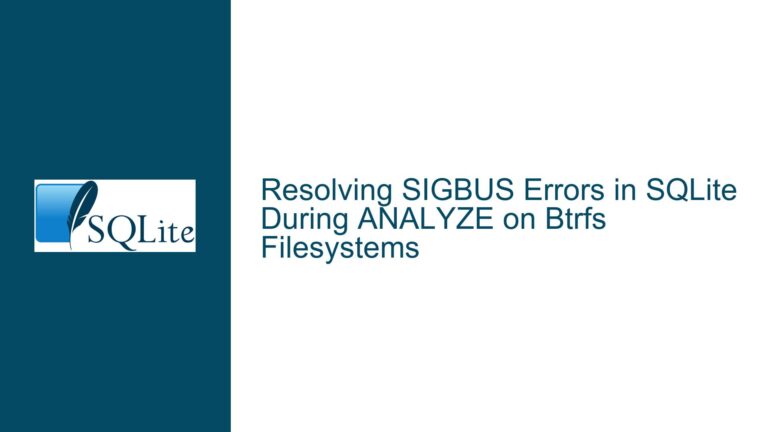SQLite Vector Search Extension: Limitations, Challenges, and Solutions
Integrating Vector Search in SQLite: The Promise and the Hurdles
SQLite, known for its lightweight and ACID-compliant nature, has long been a go-to database for applications requiring embedded or local storage. However, as the demand for vector search capabilities grows—driven by applications like semantic search, recommendation systems, and Retrieval-Augmented Generation (RAG)—SQLite’s lack of native support for vector operations has become a noticeable gap. Extensions like sqlite-vss aim to bridge this gap by integrating vector search functionality, leveraging libraries such as Faiss. While this integration holds immense potential, it also introduces several challenges and limitations that need to be addressed for broader adoption.
This post delves into the core issues surrounding SQLite’s vector search capabilities, exploring the technical hurdles, potential causes, and actionable solutions to make SQLite a viable choice for vector-based applications.
The Current State of Vector Search in SQLite: Limitations and Use Cases
The integration of vector search into SQLite is primarily achieved through extensions like sqlite-vss, which brings Faiss-based vector similarity search to SQLite. Faiss, a library developed by Facebook AI, is renowned for its efficiency in handling large-scale vector searches. However, the marriage of SQLite and Faiss is not without its challenges.
One of the most significant limitations is the 1GB storage limit imposed by sqlite-vss. This restriction stems from the way Faiss handles vector indices, which are memory-intensive by design. For example, OpenAI’s ada embeddings, which use 1536 dimensions, can store approximately 160,000 vectors before hitting this limit. While this might suffice for smaller datasets, it falls short for applications requiring millions of vectors, such as enterprise-level recommendation systems or large-scale semantic search engines.
Another critical limitation is the requirement for vectors to be stored in memory. Faiss operates under the assumption that vector indices reside in memory for optimal performance. This design choice, while beneficial for speed, poses a challenge for SQLite, which is often used in resource-constrained environments. The memory requirement can quickly become a bottleneck, especially when dealing with high-dimensional vectors or large datasets.
Additionally, sqlite-vss currently lacks support for additional filters on top of K-Nearest Neighbors (KNN) searches. This limitation restricts the ability to perform complex queries that combine vector similarity with traditional SQL filtering. For instance, a user might want to find the most similar vectors to a given query but only within a specific category or date range. Without support for such filters, the utility of sqlite-vss is significantly diminished for many real-world applications.
Despite these limitations, the integration of vector search into SQLite offers compelling advantages. SQLite’s ACID compliance ensures data integrity, making it an attractive option for applications requiring robust transactional support. Moreover, SQLite’s Full-Text Search (FTS) capabilities can complement vector search, enabling hybrid search solutions that combine keyword-based and semantic search.
Root Causes of Limitations in SQLite Vector Search Extensions
The limitations of sqlite-vss and similar extensions can be traced back to several underlying causes, ranging from the design of Faiss to the inherent characteristics of SQLite.
Faiss’s Memory-Intensive Design
Faiss is optimized for performance, which often comes at the cost of memory usage. The library assumes that vector indices are stored in memory, allowing for rapid similarity searches. However, this design choice conflicts with SQLite’s lightweight and disk-based nature. SQLite is designed to operate efficiently in environments with limited memory, making it a poor fit for Faiss’s memory-heavy requirements. This mismatch is the primary reason for the 1GB storage limit and the need to store vectors in memory.
SQLite’s Storage Model
SQLite’s storage model is optimized for traditional relational data, which is typically stored in rows and columns. Vector data, on the other hand, is inherently multidimensional and requires specialized indexing techniques. While SQLite supports extensions like sqlite-vss, its core architecture is not designed to handle vector operations natively. This lack of native support necessitates workarounds, such as virtual tables, which can introduce performance bottlenecks and storage limitations.
Lack of Filter Support in KNN Searches
The absence of additional filters in KNN searches is a direct consequence of how Faiss processes vector queries. Faiss focuses solely on finding the nearest neighbors based on vector similarity, without considering other attributes or metadata. Integrating traditional SQL filters into this process would require significant modifications to both Faiss and SQLite, as well as careful optimization to avoid performance degradation.
Dependency Management
Faiss is a complex library with numerous dependencies, making it challenging to compile and distribute. This complexity is at odds with SQLite’s philosophy of simplicity and portability. The reliance on Faiss also limits the flexibility of sqlite-vss, as any changes or improvements to Faiss must be carefully integrated into the extension.
Addressing the Challenges: Solutions and Future Directions
While the limitations of sqlite-vss and similar extensions are significant, they are not insurmountable. Several strategies can be employed to overcome these challenges and enhance SQLite’s vector search capabilities.
Increasing the Storage Limit
The 1GB storage limit is a major constraint for many applications. One potential solution is to implement paging mechanisms that allow vector indices to be stored on disk while keeping only the most frequently accessed portions in memory. This approach would require modifications to Faiss to support disk-based indexing, which is a non-trivial task but feasible with sufficient development effort.
Another option is to leverage dimensionality reduction techniques, such as Principal Component Analysis (PCA), to reduce the size of vector indices. By reducing the number of dimensions, the storage requirements can be significantly decreased, allowing more vectors to be stored within the 1GB limit. This approach has the added benefit of improving search performance, as fewer dimensions generally result in faster computations.
Reducing Memory Usage
To address the memory requirement, developers can explore hybrid storage models that combine in-memory and disk-based storage. For example, frequently accessed vectors could be stored in memory, while less frequently accessed vectors could be stored on disk. This approach would require careful tuning to balance performance and memory usage.
Another potential solution is to optimize Faiss’s memory usage by implementing more efficient data structures or algorithms. While this would require significant expertise in both Faiss and SQLite, it could yield substantial improvements in memory efficiency.
Adding Filter Support for KNN Searches
Integrating additional filters into KNN searches is a complex but achievable goal. One approach is to pre-filter the dataset before performing the vector search. For example, if a user wants to find similar vectors within a specific category, the dataset could first be filtered by category, and then the vector search could be performed on the filtered subset. While this approach may not be as efficient as native filter support, it provides a workaround for many use cases.
Another option is to extend Faiss’s query processing to support additional filters. This would require modifying Faiss to accept and process filter conditions alongside vector queries. While this would be a significant undertaking, it would greatly enhance the utility of sqlite-vss for complex queries.
Simplifying Dependency Management
To reduce the complexity of compiling and distributing sqlite-vss, developers can explore alternative vector indexing libraries that are more lightweight and easier to integrate with SQLite. For example, libraries like Annoy or NMSLIB offer similar functionality to Faiss but with fewer dependencies and a simpler API. While these libraries may not offer the same level of performance as Faiss, they could provide a more accessible option for developers.
Another approach is to modularize the extension so that different indexing libraries can be used interchangeably. This would allow developers to choose the library that best fits their needs, whether it be Faiss, Annoy, or another option. This modular design would also make it easier to update or replace the indexing library as new options become available.
Conclusion: The Path Forward for SQLite Vector Search
The integration of vector search into SQLite represents a significant step forward for applications requiring both traditional relational data and advanced vector-based queries. While extensions like sqlite-vss have made impressive strides in bringing this functionality to SQLite, several challenges remain to be addressed. By increasing the storage limit, reducing memory usage, adding filter support, and simplifying dependency management, developers can unlock the full potential of SQLite as a vector database.
As the demand for vector search continues to grow, the SQLite community has a unique opportunity to innovate and push the boundaries of what is possible with this versatile database. With careful planning and development, SQLite could become a leading choice for applications requiring robust, ACID-compliant vector search capabilities.





